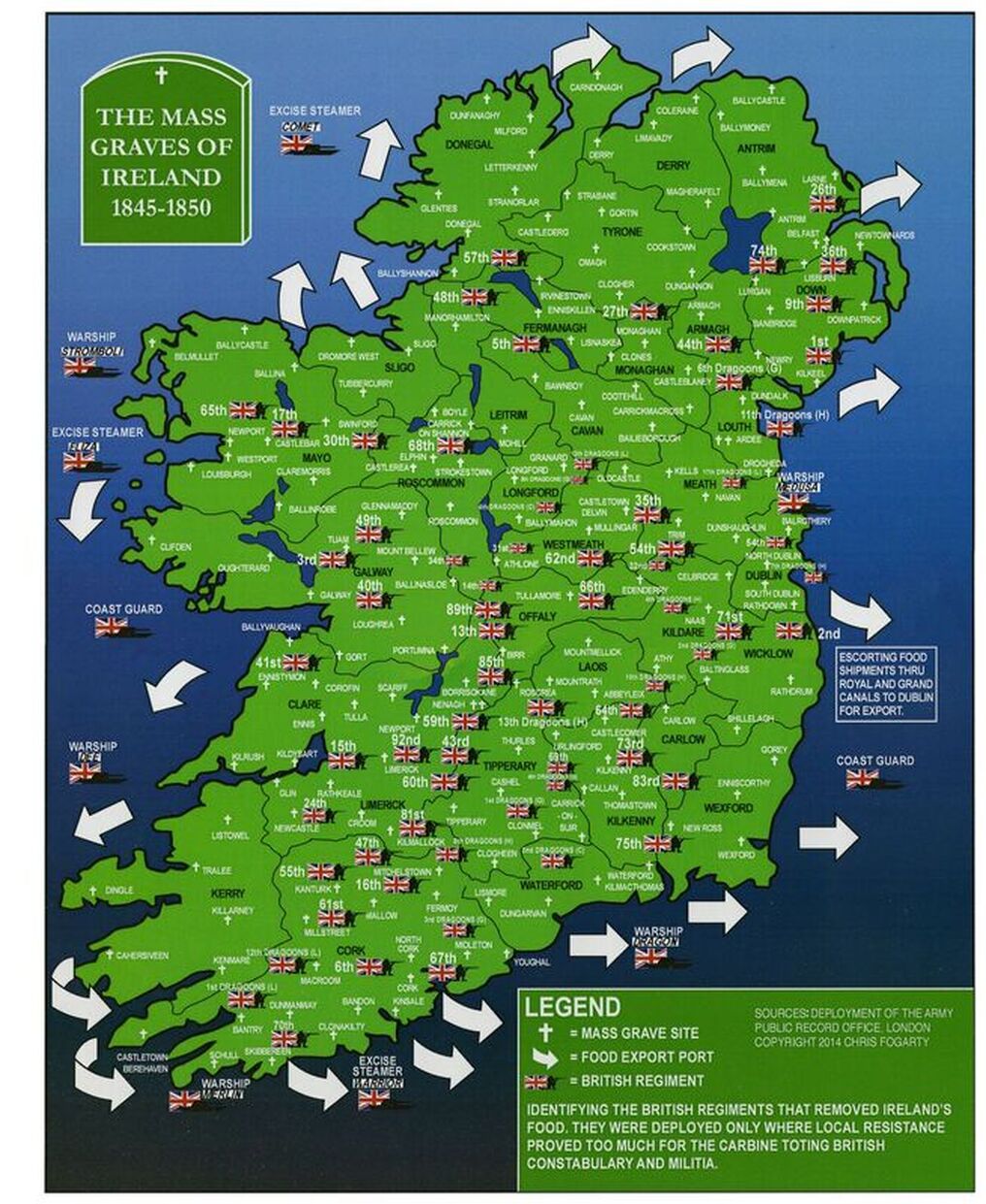A Summary of what you’ll find in The Perfect Holocaust Book
Ireland in 1845-1850 was essentially, entirely owned by English landlords, many of them Lords temporal or spiritual, in estates typically of tens of thousands of acres. Their land titles were conquest-based. On these estates the Irish were tenants-at-will on holdings of typically three to eight acres the rent of which they paid by, typically, 250-260 days of unpaid work annually on the landlord’s estate.
In previous centuries the Irish, under British rule, were non-persons, stripped of legal personhood. As murder requires personhood: the Irish were thus legally killable by any English person at will. Education was prohibited by law.
No army of English seasonal migrants produced Ireland’s vast and varied food crops. Other than the landlords’ support groups of Church of Ireland (Anglican) clergy, his doctors, lawyers, newspaper owners, the military and officers of police, the bureaucracy, etc., all of Ireland’s agricultural production was performed by the Irish people.
In and around 1845-1850, Ireland was a police State: 1,590 police stations (averaging 48 stations per county each with 8 policemen, a separate Revenue Police (1,200), Castle Police (spies, 100), and Dublin Metropolitan Police (1,100). Each county had one landlord-led militia regiment, but Dublin, Mayo, and Limerick had two each, and Cork had three.
Ireland’s abundant meats, livestock, and other foods, though produced by the Irish were claimed by the landlords. Upon international failure of potato crops, Ireland’s failure starting in 1845, Ireland’s food producers fiercely resisted police and militia efforts to remove it to the ports for export. Regular army deployments into Ireland increased to 34 regiments in 1845 and to 40 in 1850. “Black ‘47” was the food removers’ most active year. Deployment lag time explains the 1848 peak of 35.4 regiment/years. More than half of Britain’s standing army removed Ireland’s foods; 67 regiments of its total of 126 regiments and two brigades. For reference, this was more military force than was used during Britain’s conquest of the Indian Subcontinent (today’s India, Pakistan, and Bangladesh).
On July 5, 1847, in the depths of the Irish genocide, Lord Clarendon wrote from his Vice-Regal Lodge in Phoenix Park to Prime Minister Lord Russell; “Sir Edward Blakeney says that the Country is tranquil and if it were not for the harassing duty of escorting provisions, the troops would have little to do.”
The (London) Times’ contemporaneous reports of increased landings of Irish food in English ports are accessible in detail on-line.
The genocidal mass evictions and robbery of crops continued until the Land League, Boycott, and international outrage forced England to buy out its landlords from Ireland in 1900-1920. The vast estates were “striped” into typically 28-acre survival farms with an acre or two of the nearest bog for fuel and allocated to the Irish cultivators of the soil. So munificent; so far above market price, was that “golden handshake” to the departing landlords that the amortization period was set at 68.5 years. Thus my (Chris Fogarty) father and all of our neighbors in Co. Roscommon and obviously the rest of Ireland, were paying off that old “debt” into the 1970s. Ireland’s farmers paid semi-annual Rates (taxes) and those “Rents.” Ireland’s centuries of imposed destitution ended upon the end of that “Rent” payment.
In 1932 Ireland’s Fianna Fail gov’t under Taoiseach Eamon de Valera withheld the annual £4 million rent to London. Britain retaliated with an embargo on Irish goods, but it faded approaching WW2.
The use of massive armed force to starve Ireland belies the exculpatory “famine” and its synonyms “great hunger/gorta mor.” “Genocide” is accurate, but no Irish person had ever used it; it was coined post-WW2 by Raphael Lemkin to educate the US Congress as to Nazis crimes against Jews. An appropriately inculpatory label was used to report events in Ireland starting in 1846. Writers Davitt, Fitzgerald, et al. and the Cork Examiner (now Irish Examiner) repeatedly reported it as a Holocaust.
“Famine to Freedom” film is a recent concealment of the Holocaust and the British army’s perpetration of it. Its academic producers pretended to not recognize the grain-harvesting reaping hook (sickle) they excavated in Ballykilcline, Strokestown. Their “potato famine” film ignores the following non-potato food processors of 1845-1850 Ireland: 1,935 grain mills, 1,984 grain kilns, 555 flour mills, 948 livestock pounds, 144 tuck mills, 136 grain-using breweries and 72 distilleries, 62 threshers (though most was done by flail), 45 woolen mills (mutton and lamb), 43 windmills, butter churning mills, sheep folds, pig markets, corn markets, bacon stores, etc.
All was removed at gunpoint and exported.
Hundreds of Ireland’s Holocaust mass graves remain unmarked due to fear of the “Royal Dáil.”
Let us unite with relatives and friends to erect Memorial Monuments over all of Ireland’s Holocaust mass graves; each of us focusing on the mass grave nearest our ancestral home. Until abandonment of the “famine” lie, each monument must name the regiments that stripped that district of its food crops. The six existing monuments will serve as models pending a better design. Contact us (fogartyc@att.net) for any needed info.

